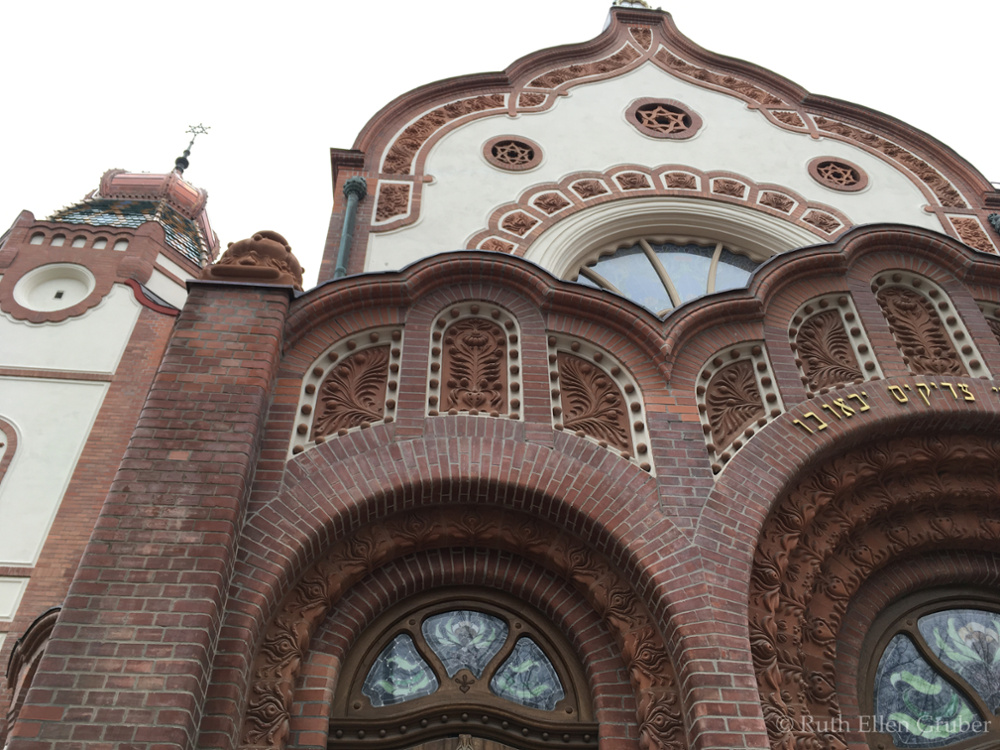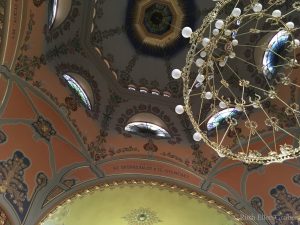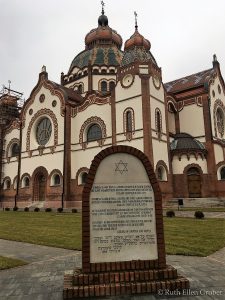by Ruth Ellen Gruber
Ruth Ellen Gruber runs the web site www.jewish-heritage-europe.eu.
This article has been drawn from her posts on the JHE website.
After more than 40 years of fitful starts and stops, the restoration of the spectacular art nouveau synagogue in Subotica has been completed, with the official dedication planned for some time in the next couple of months.
Touring the synagogue recently was a particularly emotional experience – and not just because of the stunning beauty of the building that has now been brought back to life.
Known in Hungarian as Szabadka, Subotica was part of Austro-Hungary at the time the synagogue, dedicated in 1902, was built. It was designed by the Budapest-based architects Dezső Jakab and Marcell Komor, who had submitted an almost identical concept in the architectural competition for the New Synagogue in Szeged, just over today’s border in Hungary.
Their design for Szeged lost out to a grandiose synagogue by Lipot Baumhorn. But Komor and Jakab’s synagogue was built in Subotica, where it forms a key element of the town’s art nouveau center – the pair designed the town hall, and also the buildings of the park in nearby Palić.

The synagogue stands in a yard surrounded by a wrought iron fence worked in patterns of hearts. With its glazed tile roof and zinc-clad domes, it was one of the first buildings to employ concrete and steel construction, a technique that did not become commonplace until later in the twentieth century.
Its eight-sided central dome, supported by eight steel columns, rises up from smaller, bulbous domes, sinuous gables and ornamental buttresses. A star of David tops each dome, and red brick or terracotta tiles molded into floral or other decorative shapes edge the walls.
The colorful paintings that decorate the interior feature floral motifs and recall the embroidery on peasant blouses. The richly colored stained glass windows, originally from the studio of Miksa Roth, pick up these designs.
 Subotica’s Jewish community was all but destroyed in the Holocaust. The small, surviving community was not able to maintain the synagogue, and in September 1979 it presented the building to the city, on condition that it be restored and used for cultural purposes that would accord with its original function.
Subotica’s Jewish community was all but destroyed in the Holocaust. The small, surviving community was not able to maintain the synagogue, and in September 1979 it presented the building to the city, on condition that it be restored and used for cultural purposes that would accord with its original function.
Fitful renovation work, begun in the mid-1970s, was hampered by lack of funds and lack of will. Between 1985 and 1992 the synagogue was used as an avant-garde theater, which contributed to further degradation. Structural changes led to a fire, and some of the performances even used animals that urinated in the building.
It was during that period, in 1989, that I first visited the synagogue and saw its sorry condition. Later, in 2001 I was on the board of a foundation, SOS Synagogue, that — with little success — attempted to promote the restoration of the building.
Restoration efforts only gained momentum in recent years. The synagogue became a priority project of the World Monuments Fund (WMF) – which had already put it on its “Watch List” of endangered historic buildings back in 1996, and again in 2000-2001. In 2014 Europa Nostra listed the synagogue as one of Europe’s seven most endangered buildings.
Significant funding then came from the Hungarian government, which allocated nearly €3 million, in particular for the restoration of the interior. This work took place between November 2016 and December 2017.
 The synagogue remains the property of the municipality of Subotica, but under an agreement signed in 2015 it will be managed by the city, the local Jewish community, and the Hungarian National Council of Serbia. According to Robert Sabadoš, the head of the Federation of Jewish Community in Serbia, it will be managed as a tourist attraction and concert venue — but the Jewish community will also be able to use it for services and on other occasions. He said the community will also be able to veto concerts or other events deemed inappropriate. There are also plans to install a permanent Jewish exhibition.
The synagogue remains the property of the municipality of Subotica, but under an agreement signed in 2015 it will be managed by the city, the local Jewish community, and the Hungarian National Council of Serbia. According to Robert Sabadoš, the head of the Federation of Jewish Community in Serbia, it will be managed as a tourist attraction and concert venue — but the Jewish community will also be able to use it for services and on other occasions. He said the community will also be able to veto concerts or other events deemed inappropriate. There are also plans to install a permanent Jewish exhibition.
It is fascinating to compare the Subotica synagogue with the monumental New Synagogue in Szeged, the masterpiece of Baumhorn, the most prolific synagogue architect of his age, which has also been undergoing restoration.
Built for the Neolog community and completed in 1903, the Szeged synagogue is one of the largest and most ornate in Europe. Its exterior fairly bristles with buttresses, spires, and cupolas surrounding a massive central dome, and sumptuous ornamentation covers every inch of the arched and vaulted interior: carved wood, gilding, paintings, stuccowork, and brilliant stained glass windows that incorporate Jewish symbolism.
The Hungarian government announced in 2014 that it had allocated some one billion forints (then around €3 million) for much-needed repairs on the building. Renovation of the synagogue’s exterior began in earnest in 2016 and was completed this past summer; a ceremony on September 3, 2017 celebrated the occasion.
The work included repair of the main dome, the towers, the roof, and the facade, as well as gutters and drainage. The fence and stained glass windows were repaired, and the Biblical garden designed by Rabbi Immanual Löw, who consulted with Baumhorn on many facets of the design and decorative elements, was replanted.
Lipot Baumhorn built, designed or worked on more than two dozen synagogues. Most were highly ornate buildings, featuring lofty domes, elaborate brickwork, and opulent decoration. His tombstone in Budapest’s main Jewish cemetery lists more than 20 of his projects and bears a relief carving of the dome of the Szeged synagogue; his epitaph describes his creations as “synagogues that look toward heaven and awaken piety.”
Some were destroyed during or after World War II. But a number still stand in various parts of today’s Hungary, as well as in neighboring regions of Slovakia, Romania and Serbia.
A few (such as in Brasov, Romania, and in Budapest and Nyiregyhaza, Hungary) are used for worship. Some have been converted for other use, ranging from cultural spaces or museums (Szolnok, Hungary; Budapest; Nitra, Slovakia) to sports halls (Budapest and Cegled, Hungary). Near Subotica, the grandiose Baumhorn synagogue in Novi Sad, Serbia was restored for use as a concert hall.
The Baumhorn synagogue in Lučenec, Slovakia stood for decades as a ruin. But it, too, has undergone recent renovation – a fullscale reconstruction completed in 2016 that transformed it into a cultural center that also includes a memorial to the Holocaust.
Completed in 1926, the immense domed structure is the only surviving synagogue out of five that once stood in Lučenec, which is in southern Slovakia near the border with Hungary. The communist authorities nationalized the synagogue in 1948 and for more than 30 years it was used as a warehouse for artificial fertilizers. It stood empty and dilapidated after being abandoned in 1980.
The building received a new roof in the 1990s, but for lack of funding plans for full restoration never got off the ground until 2015, when active work on the restoration was able to begin, financed by a €2.3 million EU grant.
One major Baumhorn synagogue still stands empty and in sad disrepair – the so-called Fabric synagogue in Timisoara, Romania. Like many Baumhorn synagogues, it features a tall dome, cupolas, massive arches and rose windows. Its fate, however, remains uncertain.





Follow us: